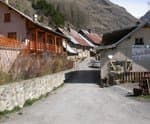The Chargès source
The first encounter with the Chargès torrent is quite strange: a "giant’s cauldron" has been dug out of the hard rock, forming a reservoir that seems to be bubbling. Later, along the torrent, calm gradually returns until the arrival at the source in the hollow of the corrie.
14 points of interest
 Vernacular heritage
Vernacular heritageCommunal oven
This is located in the basement of the former school (now the Park Information Centre). It is regularly used on the occasion of local festivals and events. Architecture
ArchitectureHamlet of Les Gourniers
The old houses of the hamlet are modest in appearance. They are built from stone and have sheet metal roofs. They used to be roofed with slate extracted from the nearby quarries Architecture
ArchitectureChapel of the Nativity
It is difficult to be sure of the chapel's date of construction, but is existed in 1700. The bell was installed in 1870, but the bell tower was built in 1956. In 2013, a new larch shingle roof replaced the old corrugated iron roof, Fauna
FaunaBlack Woodpecker
This funny red bird with a red helmet and a long light coloured beak is the biggest woodpecker in the Alps. It is difficult to see because it is very solitary and distrustful. However, thanks to numerous clues that reveal its presence, it is possible to place its song and its very typical and sonorous. It taps endlessly to defend its territory and to find bark beetles or carpenter ants.
 Fauna
FaunaLong Tailed Tit
This Tit is easily recognizable thanks to its ball of feathers coloured white, black, brown and pink, extended by a very long tail. Not very selective, it adapts to all kinds of forest environments as long as they are dense. Although it is more common on the plain, it is also present in the mountains up to an altitude of 2 000 m in the Alps. Unlike other tits, the Long Tailed Tit nests in a spherical and flexible nest which grows little by little as the young birds develop.
 Fauna
FaunaRock Bunting
The Rock Bunting is mainly a Southern mountain species. In the cold season, it migrates towards the valleys or the plains. In Spring, from the top of a bush, sings his song, agreeable but not very remarkable or loud. As long as you are discreet and attentive, it is possible to sometimes hear his little "tsip", high-pitched brief cries.
 Fauna
FaunaWallcreeper
Discreetly hanging onto the cliff thanks to its long clawed feet, the Wallcreeper is on a search for insects and spiders that it’s long, narrow, curved beak enables it to extract. The unique representative of the Tichodroma family, the Wallcreeper dominates the vertical mountain wall where it finds its home and safety. Not a shy species, it is emblematic of the mountain region, the Wallcreeper sometimes moves closer to the villages in Winter.
 Fauna
FaunaShort Toed Snake Eagle
Spring has only just returned when you can hear cries as loud as the church bells. You have to lift your head up to admire two large birds flying together, alternating aerobatics and hovering in the sky like two silver coloured kites playing with the wind.. Their light stocky silhouette and their darker head enable you to identify the Short-toed Snake Eagle. It mainly feeds on reptiles (lizards and snakes) which it captures by the head, which it can then regurgitate in order to feed its young.
 Fauna
FaunaRed-billed chough
The cliff overlooking the path beyond the chapel of Saint-Marcellin, is home to several pairs of red-billed chough, faithful to their territory. Part of the corvid family, it is strikingly similar to the Alpine chough. It takes a little experience to tell them apart. the beak is the best guide: red, long and curved for the red-billed chough, yellow and short for its yellow-billed cousin. It specialises in plummeting through the air, spiralling and performing loops.
 Fauna
FaunaEurasian Crag Martin
The Eurasian Crag Martin has beige hardly contrasted feathering. It is capable of real prowess in flight, a quality that is indispensable for catching the multitude of insects that it feeds on. In Spring, once it has found a rocky ridge, the Eurasian Crag Martin endlessly transports mud and pieces of vegetation with its beak. Using this unique tool it solidly fixes each element to the edifice of the rock with a clever mix of saliva and water.
 Pastoralism
PastoralismCabane du Pré d'Antoni
Perched above the rushing mountain stream, this cabin is used by shepherds - in addition to that of Chargès - during the period of summer grazing for the cows from the Réallon valley. Traditionally, on 14 July, a herd of 370 animals leaves Les Gourniers at dawn and heads up to the alpine pasture of Chargès for two months. On that day, called the amontagnage, everyone can take part.
 Fauna
FaunaChamois
An emblematic animal in the Alps, the chamois or « rock goat » has short curled horns. Like the Ibex, it is easy to observe through binoculars. The goats and esterlons (young males aged one year) like to live in big herds ; in contrast, the billy goats stay quite isolated only rejoining the females during the mating season. In the winter, the chamois need a lot of tranquility in order to conserve their reserve of fat which they need in order to survive...
 Fauna
FaunaWhite-throated dipper
The white-throated dipper is easy to spot as long as you are unobtrusive. It lives on the banks of rivers and mountain streams. A small russet and grey bird with a short tail and a slender beak, with a white throat and breast. This astonishing passerine bird has the unusual habit of walking underwater against the current, in search of food. It flattens itself and anchors itself to the bottom with its claws, opens its eyes - which are protected from the force of the flow by a fine membrane - and seeks out larvae, small crustaceans and fish.
 Fauna
FaunaWater pipit
This small passerine bird can remain invisible, flying against the blue of the sky, which makes it very difficult to spot. On the other hand, it can make itself heard, calling out its name « pi-pit-pipit-pipit-pipit » and suddenly, at the peak of its flight, gliding earthwards, its unfurled wings acting like a parachute, uttering a joyful « piiiiii » call. When it alights in the grass in the alpine meadow, it can be difficult to see among the clumps of wood fescue.
Description
From Les Gourniers car park, cross the village and follow the path to the Saint-Marcellin Chapel.
- The path then makes its way around the mountainside to a footbridge (Pont la Claie), then goes up to the Pré d’Antoni cabin.
- Continue as far as a torrent (footbridge).
- Go up a grassy slope to get to a flatter section and the Chargès source.
- Departure : Les Gourniers, Réallon
- Towns crossed : Réallon
Altimetric profile
Recommandations
Between Chapelle-Saint-Marcellin and the Claie bridge, there is a danger of falling stones, especially during strong rainfall. The route is not recommended in this case.
Information desks
Information center "les Gourniers" (summer only)
Les Gourniers, 05160 Réallon
Les Gourniers
05160 Réallon
Tel :
embrunais@ecrins-parcnational.fr
Maison du Parc de l'Embrunais
Place de l’Église, 05380 Châteauroux-les-Alpes
Information, documentation, exhibition, screenings, products and books of the Park. Accessible to people with reduced mobility. Free admission. All animations of the Park are free unless otherwise stated.
Access and parking
From Savines-le-Lac, take the D41 to Réallon. Then follow the D241 to the village of Les Gourniers at the bottom of the valley.
Parking :
Source

Report a problem or an error
If you have found an error on this page or if you have noticed any problems during your hike, please report them to us here:


